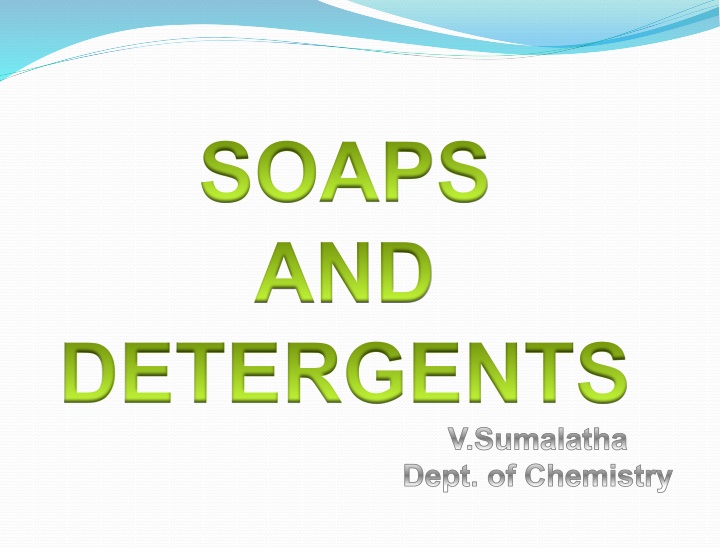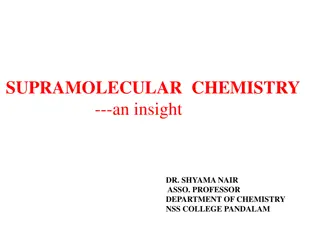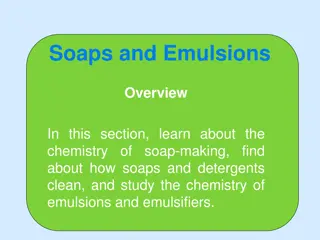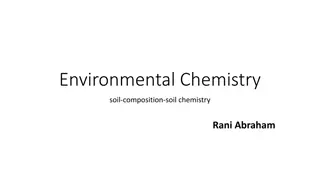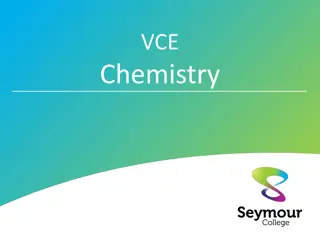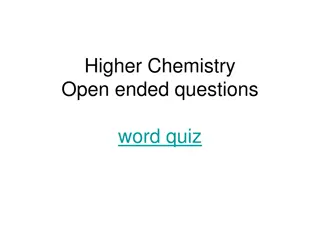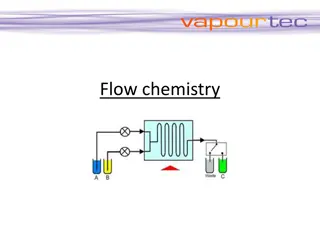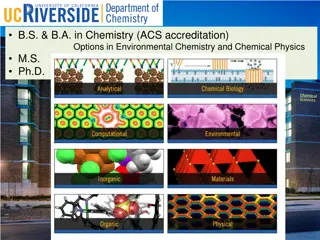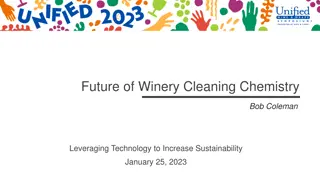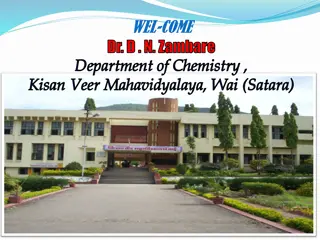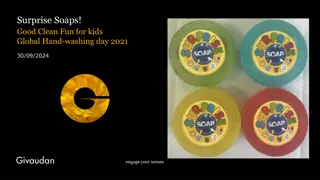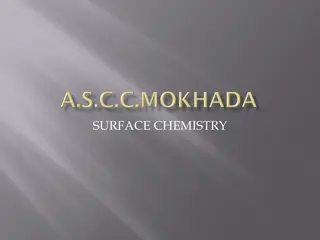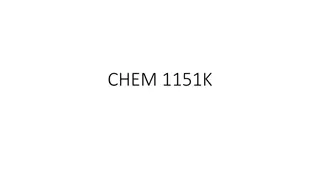Soaps and Detergents: Chemistry Insights
Delve into the world of soaps and detergents through this comprehensive guide. Explore the chemistry behind cleansing actions, saponification process, micelles, and the differences between soaps and detergents. Discover the mechanisms and advantages of using these cleaning agents.
Uploaded on Sep 14, 2024 | 4 Views
Download Presentation

Please find below an Image/Link to download the presentation.
The content on the website is provided AS IS for your information and personal use only. It may not be sold, licensed, or shared on other websites without obtaining consent from the author.If you encounter any issues during the download, it is possible that the publisher has removed the file from their server.
You are allowed to download the files provided on this website for personal or commercial use, subject to the condition that they are used lawfully. All files are the property of their respective owners.
The content on the website is provided AS IS for your information and personal use only. It may not be sold, licensed, or shared on other websites without obtaining consent from the author.
E N D
Presentation Transcript
SOAPS AND DETERGENTS V.Sumalatha Dept. of Chemistry
CONTENTS DETERGENT Introduction Cleansing action of detergents SOAP Introduction Saponification Soap molecule (Micelles) Cleansing action of soaps Advantages and disadvantages DIFFERENCES BETWEEN SOAPS AND DETERGENTS
SOAPS Soaps are the sodium and potassium salts of the long chain carboxylic acid.A soap molecule consists of a long hydrocarbon chain (composed of carbons and hydrogens) with a carboxylic acid on one end which is ionic bonded to metal ion usually a sodium or potassium. A soap has a large non-ionic hydrocarbon group and an ionic group COO-Na+.
EXAMPLES OF SOAPS Sodium stearate (Chemical formula: C17H35COO- Na+) Sodium palmitate (Chemical formula: C15H31COO- Na+) Sodium oleate (Chemical formula: C17H33COO-Na+)
SAPONIFICATION The process of making soap by the hydrolysis of fats and oils with alkalies is called saponification. Soap is made by heating animal fats or vegetable oil with concentrated sodium hydroxide (NAOH). Fat or Oil + NaOH Soap + Glycerol
MICELLES SOAP MOLECULES A soap molecule has two ends with different properties- 1. A long hydrocarbon part which is hydrophobic (i.e. it dissolves in hydrocarbon). 2. A short ionic part containing COO-Na+ which is hydrophilic (i.e. it dissolves in water). micelle
MECHANISM OF SOAPS When a dirty cloth is put is put in water containing soap than the hydrocarbon ends of the soap molecule in the micelle attach to the oil or grease particles present on the surface of dirty cloth. In this way the soap micelles entraps the oily particles by using the hydrocarbon ends. The ionic ends of the soap molecules remain attached to the water when the dirty cloth is agitated in soap solution. The oily particles presents on its surface gets dispersed in the water due to which the cloth gets clean.
ADVANTAGES & DISADVANTAGES DISADVANTAGES Soaps are not suitable in the hard water. They have weak cleansing properties than detergents. ADVANTAGES Soaps are eco- friendly and bio degradable
DETERGENTS Detergents are the sodium salts of long chain benzene sulphuric acids. Detergents are primarily surfactants, which could be produced easily from petrochemicals. Surfactants lower the surface tension of water, essentially making it 'wetter' so that it is less likely to stick to itself and more likely to interact with oil and grease. The ionic group is in a detergent is
EXAMPLES OF DETERGENTS Two basic examples of well-known detergents of the sulphonate group or the sulphate group are:
CLEANSING ACTION OF DETERGENTS Synthetic detergents have the same type of molecular structure as soaps i.e. a tadpole like molecule having two parts at each end i.e., one large non-polar hydrocarbon group that is water repelling (hydrophobic) and one short ionic group usually containing the or group that is water attracting (hydrophilic). Thus the cleansing action is exactly similar to that of soaps whereby the formation of micelles followed by emulsification occurs. However, synthetic detergents can lather well even in hard water. This is because they are soluble sodium or potassium salts of sulphonic acid or alkyl hydrogen sulphate and similarly form soluble calcium or magnesium salts on reacting with the calcium ions or magnesium ions present in water. This is a major advantage of the cleansing property of detergents over soap.
ADVANTAGES OF DETERGENTS Since detergents are the salts of strong acids they do not decompose in acidic medium. Thus detergents can effectively clean fabric even if the water is acidic. Synthetic detergents are more soluble in water than soaps. They have a stronger cleansing action than soaps. As detergents are derived from petroleum they save on natural vegetable oils, which are important as essential cooking medium
DISADVANTAGES OF DETERGENTS Many detergents are resistant to the action of biological agents and thus are not biodegradable. Their elimination from municipal wastewaters by the usual treatments is a problem. They have a tendency to produce stable foams in rivers that extend over several hundred meters of the river water. This is due to the effects of surfactants used in their preparation. Thus they pose a danger to aquatic life. They tend to inhibit oxidation of organic substances present in wastewaters because they form a sort of envelope around them.
DIFFERENCES BETWEEN SOAPS AND DETERGENTS SOAPS They are metal salts of long chain higher fatty acids. These are prepared from vegetable oils and animal fats. They cannot be used effectively in hard water as they produce scum i.e., insoluble precipitates of Ca2+, Mg2+, Fe2+ etc. DETERGENTS These are sodium salts of long chain hydrocarbons like alkyl sulphates or alkyl benzene sulphonates. They are prepared from hydrocarbons of petroleum or coal. These do not produce insoluble precipitates in hard water. They are effective in soft, hard or salt water.
